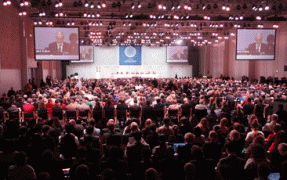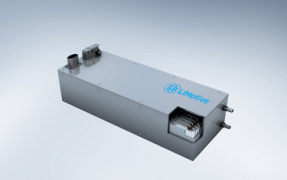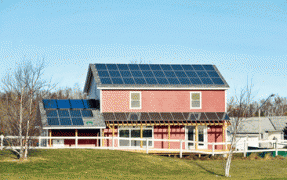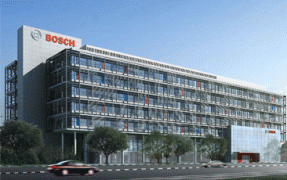Green Technology: Solutions for Climate Change
Since the end of 2009, the global community has committed itself to the target of limiting global warming to less than 2 degrees Celsius. According to scientific studies, global greenhouse gas emissions must be cut by at least 50 percent by 2050 if this goal is to be achieved. With no concrete objectives having been agreed internationally, it is now more important than ever to use innovations and technological solutions as a means of reducing CO2 emissions. That is one of the reasons why green technology is now a key market worldwide – one that is estimated to grow at a rate of 6.5 percent per year, reaching €3,200 billion by 2020. Bosch aims to provide technological solutions to ecological challenges and, in doing so, also boost its economic position.
2009 – A year lost?
Two years before the UN Climate Change Conference in Copenhagen, Ban Ki moon urged the Global Compact participants to make climate change a leadership issue within companies’ business strategies. Introducing the Caring for Climate (C4C) initiative, the UN Secretary-General expected companies to set emission-reduction targets, explore low-carbon technologies, share experiences, disclose progress, and support public policy efforts.
Looking at the Carbon Disclosure Project (CDP), it can be seen that efforts have moved ahead. Since it was launched in 2003 worldwide, the number of companies reporting their greenhouse gas emissions and their climate strategies has grown tenfold. Starting with 235 companies and increasing to 1,449 in 2007, the figure rose to 2,204 in 2008. From the corporate side, this is a signal that leadership and transparency concerning climate change are on the rise.
If we then look at the global level and to the results of the Copenhagen conference, where we were present, the picture looks quite different and forward movement is hardly obvious. Honestly speaking, our expectations regarding that were not so high. We know that climate protection is a common problem that has to be solved through shared commitments. Our hope on the political level is that, at the very least, this insight becomes more commonplace.

Technology to protect the climate
Bosch has been a member of the UN Global Compact since 2004. We are neither a signatory of the C4C initiative nor, as a non-listed company, do we participate in the CDP. Nonetheless, we fully support and pursue the goals represented by these initiatives. We consider climate change to be both a challenge and an opportunity. According to a study by the World Business Council for Sustainable Development – also used in the preparations for the Climate Change Conference in Copenhagen – the construction industry is responsible for 40 percent of worldwide greenhouse gas emissions, more than any other industry. However, the study, “Energy-efficiency in buildings,” also concludes that it is possible to reduce these CO2 emissions by 60 percent by 2050. We believe that with energy-efficient condensing technology, solar thermal systems, and heat pumps, our Thermotechnology division offers not only opportunities to achieve major cuts in CO2 but also enormous market potential. In each of the business sectors of the Bosch Group, there are comparable technologies and products that have the potential to contribute to both climate protection and our business. We made some important progress in this respect in 2009.
Climate protection as a matter of trust
Setting climate protection targets means sticking to those targets at all costs, even in times of economic crisis. At the beginning of 2009, the Bosch board of management and the individual divisions agreed to implement a range of measures to increase energy efficiency. By 2020, the aim is to cut worldwide CO2 emissions at all manufacturing sites by at least 20 percent compared to 2007 levels. Although Bosch has hardly any energy-intensive manufacturing processes, we are nonetheless keen to boost our potential in this area by setting internal targets, implementing continuous reporting, and raising awareness among associates. At a sustainability congress, chairman of the Bosch board of management, Franz Fehrenbach, called on businesses to intensify their climate protection activities, even in such difficult times. He said that by taking a serious, consistent approach to climate protection, companies would benefit financially and gain more trust. Bosch is confident that green technology has a key role to play in riding out this crisis.
Research for the post-oil era
The Bosch credo is to provide technological answers to ecological questions. To that end, Bosch invests some 45 percent of its research and development budget in technologies that help conserve resources and energy, generating a strong third of its sales with such products. Given the finite nature of fossil fuels, Bosch is using its research program to prepare for the post-oil era. In line with its strategic slogan “Invented for life,” the company is working on a range of topics including lithium-ion batteries, alternative drive systems for vehicles, energy-efficient household appliances, and ways to supply renewable energies using photovoltaic technologies, for example.

Batteries for electric travel
In automotive technology, every second euro the company spends on research and development goes toward protecting the environment and conserving resources. In addition to expanding existing areas of innovation, the company is also moving into new territory, such as the electrification of the drivetrain. Here, Bosch is working with Samsung SDI as part of the joint venture SB LiMotive. In 2009, the two partners took on a total of 500 associates for a project focusing on cutting-edge lithium-ion batteries. A further milestone was reached in 2009 with the ground-breaking ceremony for a new plant in Korea. By the end of 2012, the facility will have the capacity to produce at least 125,000 lithium-ion battery cells per year for hybrid and electric vehicles.
Investment in renewable energies
According to the latest estimates by its member states, the European Union is well on the way to sourcing over 20 percent of its power from renewable energies by 2020, thus achieving its self-imposed target. In 2009, Bosch generated sales of roughly €1 billion from systems utilizing renewable energies, ranging from large wind-turbine gearboxes and ground-source heat pumps to solar collectors and photovoltaics. Bosch is also committed to achieving growth through renewable energies in the future and, in 2009, opened a new manufacturing facility for large wind-turbine gearboxes in Nuremberg, Germany. By 2013, Bosch will have invested a total of €180 million in this gearbox plant belonging to its subsidiary Bosch Rexroth. “We have invested in wind energy, solar technology, and heat pumps,” says Franz Fehrenbach. “With this new plant for the manufacture of large gearboxes, we are continuing our investments in the promising market of renewable energies.”
New division: Bosch Solar Energy
Since the acquisition of solar cell manufacturer ersol Solar Energy AG in 2008, Bosch has intensified its activities in the field of photovoltaic technology. This illustrates the company’s strategy of using acquisitions to expand its portfolio of climate- and environmentally-friendly technologies and strengthen its position in the renewable energies sector. After acquiring majority holdings in two further solar module manufacturers – aleo solar AG and Johanna Solar – the Bosch Group clustered its photovoltaic activities in 2009 by forming the new division Bosch Solar Energy AG. To boost the competitiveness of photovoltaic power generation and raise its profile as part of a sustainable energy mix, Bosch Solar Energy is working to not only increase the efficiency of its cells and modules, but also cut manufacturing costs. At the end of 2009, Bosch Solar Energy set up its first solar power plants, including a photovoltaic system for Stuttgart airport. Bosch Solar Energy AG hopes that its collaboration with Allianz Climate Solutions GmbH will result in further large-scale photovoltaic projects, particularly projects exceeding 1 MW output. Bosch Solar Energy also supports the Solar Energy Foundation, a body that has set itself the goal of further expanding the use of photovoltaics in Africa in order to alleviate poverty and improve living conditions. Projects in Lesotho in South Africa and in Burundi have made it possible to supply two local hospitals with solar power.

Eco Plus Home
Efforts made by Bosch to harness renewable energies and increase the energy efficiency of buildings are reflected in the company’s Thermotechnology division and in its own buildings. Projects such as the Eco Plus Home in Canada and the new Bosch headquarters in Shanghai are a great step in the right direction.
The Eco Plus Home, a model house that is ready for series production, aims to prove that it is possible to generate a virtually CO2-free energy supply exclusively from renewable energies while still enjoying a comfortable lifestyle. In the eastern Canadian province of New Brunswick, a family of six will spend a year living without oil or gas in the Eco Plus Home. The building technology supplied by Bosch includes an electric heat pump, a solar thermal system, and a photovoltaic installation. While a conventional home generates average CO2 emissions of around eight metric tons, the Eco Plus Home reduces this figure to virtually zero. Although electricity is required to operate the heat pump, the photovoltaic installation generates significantly more CO2-free power over the course of a year than the heat pump consumes. This means that, even in the harsh Canadian winter, the building maintains its green credentials the entire year. On conclusion of the experiment, the climate-friendly prefabricated house is to be marketed in Canada and the United States at the same price as conventional homes.

Green building award
Even before its completion last year, the new Bosch headquarters for Southeast Asia in Singapore had received awards for its energy efficiency and eco-friendliness. The State of Singapore awarded the new building the Platinum rating, the highest under its “Green Mark” program. The building also received the national Clean Energy Program’s “Solar Pioneer Award.”
The new headquarters is one of the first buildings in Singapore to be equipped with mobile external sunscreens. These cut the amount of heat getting into the building by 20 to 25 percent, thereby reducing the energy requirements for cooling – an important consideration in a city located close to the equator. The building has also been fitted with photovoltaics from Bosch Solar Energy. A number of other factors further boost the building’s green credentials. Recovering energy in the ventilation system reduces the amount of energy required for cooling by a further 20 percent.
The green headquarters in Singapore is just one example of how Bosch ensures efficient use of energy in its own construction activities around the globe. The company’s new Chinese headquarters in Shanghai, for example, covers half its heating and cooling requirements with ground-source heat pumps. Photovoltaics have also been installed at certain locations in Germany, such as Murrhardt and Reutlingen.
Climate protection counts
Climate protection is one of the biggest challenges we face, and one that demands clear targets and a great deal of commitment. When it comes to climate change, Bosch provides a very wide range of sustainable solutions. Internally, Bosch is seeking to make associated savings by reaching its CO2 reduction target by 2020 and implementing initiatives in the building sector, for example. Bosch sees great leverage within its business fields. With a broad range of technical solutions and technological innovations, the company can help its customers increase energy efficiency and harness the power of renewable energies. As part of this, we also aim to play our part in shaping key markets for environmental technology in the period leading up to 2020. Climate protection is absolutely fundamental to ensuring we enjoy long-term success.
At a glance: Bosch climate initiatives in 2009
- Production: At the beginning of 2009, Bosch set itself the goal of reducing relative CO2 emissions by 20 percent by 2020.
- R&D: In 2009, Bosch invested some 45 percent of its research and development budget in technologies that help conserve resources and energy, generating sales of a strong one billion euros with such products.
- Innovation: The ground-breaking ceremony for a new plant in Korea was held in 2009. By the end of 2012, the facility will have the capacity to manufacture a minimum of 125,000 lithium-ion battery cells per year for hybrid and electric vehicles.
- Investments: In 2009, Bosch opened a new manufacturing facility for large wind-turbine gearboxes in Nuremberg, Germany. Approximately €180 million will have been invested in this project by 2013.
- Renewable energies: In 2009, Bosch generated sales of roughly €1 billion from systems utilizing renewable energies, ranging from large wind-turbine gearboxes and ground-source heat pumps to solar collectors and photovoltaics.
- New division: The recently formed Bosch Solar Energy division installed its first solar power plants in 2009.
- Awards: The new Bosch headquarters for Southeast Asia in Singapore was completed in 2009 and received two awards for its energy efficiency and eco-friendliness.
This project description was originally presented in the Global Compact International Yearbook 2010.
About Bosch Group
The Bosch Group comprises Robert Bosch GmbH and its roughly 350 subsidiaries and regional companies in some 60 countries. If its sales and service partners are included, then Bosch is represented in roughly 150 countries. This worldwide development, manufacturing, and sales network is the foundation for further growth. Bosch spent some 4.2 billion euros for research and development in 2011, and applied for over 4,100 patents worldwide. With all its products and services, Bosch enhances the quality of life by providing solutions which are both innovative and beneficial.
The company was set up in Stuttgart in 1886 by Robert Bosch (1861-1942) as “Workshop for Precision Mechanics and Electrical Engineering.” The special ownership structure of Robert Bosch GmbH guarantees the entrepreneurial freedom of the Bosch Group, making it possible for the company to plan over the long term and to undertake significant up-front investments in the safeguarding of its future. Ninety-two percent of the share capital of Robert Bosch GmbH is held by Robert Bosch Stiftung GmbH, a charitable foundation. The majority of voting rights are held by Robert Bosch Industrietreuhand KG, an industrial trust. The entrepreneurial ownership functions are carried out by the trust. The remaining shares are held by the Bosch family and by Robert Bosch GmbH.
Bosch group focuses on three main business sectors:
- Automotif Technology
- Industrial Technoly
- Consumer goods and Buildings technology
About Us // Privacy Policy // Copyright Information // Legal Disclaimer // Contact
Copyright © 2012-2018 macondo publishing GmbH. All rights reserved.
The CSR Academy is an independent learning platform of the macondo publishing group.









